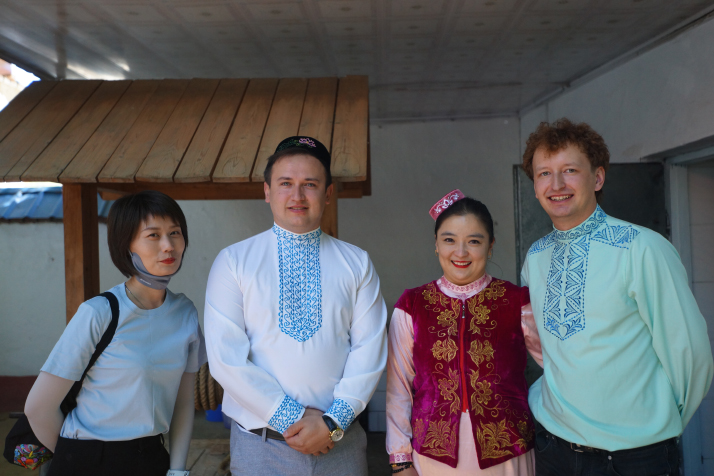
The author (left) visits an ethnic minority family in Tacheng Prefecture in 2021 (COURTESY PHOTO)
As someone who has been learning English for over 20 years, my first real culture shock didn't occur when studying abroad—it came when I first moved to Beijing from Xinjiang as a teenager. It was the early 2000s, a time when the Internet in China was just beginning to gain momentum, and the differences between regions felt vast.
Upon arriving in the capital city, I was struck by how many Han Chinese restaurants there were—the Han ethnic group being the largest among the 56 ethnic groups in China, making halal restaurants seem relatively scarce in comparison. In Xinjiang, the opposite was true. Halal restaurants dominated the culinary scene, while Han restaurants, often featuring pork dishes, were just one of the many options.
For me, Beijing's food culture felt like a melting pot of different provinces, mostly with Han characteristics, plus a sprinkling of international flavors. In contrast, Xinjiang's cuisine had a distinctly international vibe, shaped by centuries of Silk Road exchanges. From Russian bread to Kazak yogurt and Mongolian dairy products, Xinjiang's food culture reflected its energetic ethnic diversity.
Two vs. three hours
Geography plays a role. A flight from Urumqi, capital of Xinjiang, to Almaty, Kazakhstan, takes under two hours, while flying to Beijing takes more than three. Growing up in Xinjiang, I was surrounded by people who looked nothing like the typical East Asian faces that I was familiar with. But I didn't think of people in terms of their ethnicity or appearance. Instead, I saw them as neighbors, classmates and friends.
It wasn't until years later, during an interview in Tacheng Prefecture, that I began to deeply reflect on Xinjiang's unique diversity. Tacheng, which borders Kazakhstan, is home to about 30 ethnic groups, including Kazaks, Uygurs, Huis, Mongolians, Russians and Tatars, who together make up roughly 40 percent of the population. It's not uncommon to find families with members from multiple ethnic backgrounds.
I remember asking Gulan, a local Kirgiz woman, how her family—which includes relatives of Russian, Mongolian, Uygur and Han descent—navigates potential conflict caused by ethnic differences. Her response caught me off guard, "Why do you have this question? Whenever I'm asked this, I don't know what to say."
Her words stayed with me. They reminded me of an invaluable lesson from my hometown: When faced with differences, focus on finding common ground rather than emphasizing what sets us apart. Harmony, after all, is born out of shared connections, not divisions. Over time, I came to understand the answer to my own question. What keeps diverse families together is love—the willingness to respect one another and solve problems together despite differences.
Ethnicity is just one of many ways people differ. Why should it be singled out? Differences in gender, age, education and upbringing are equally important, yet they don't always receive the same scrutiny.
Overlapping spheres
Samat Kurbanjan, a well-known photographer and documentary filmmaker from Xinjiang, once told me, "Xinjiang cannot be represented by Uygurs alone. This region is home to dozens of ethnic groups, and its progress is the result of contributions from all of them, not just one."
Samat also uses Tacheng as an example. He describes Xinjiang as a mosaic of ethnic cultures, bound together by mutual respect. "This respect has lasted for generations," he said. "That's what makes Xinjiang so special." Like Samat, I feel proud to call myself a Xinjianger because of this enduring spirit of diversity and unity.
The respect for different ethnic customs and religious practices is deeply rooted in Xinjiang's culture and, in recent years, has spread more widely across China with the rise of social media. More people are beginning to appreciate the rich traditions of border areas like Xinjiang—while Xinjiang netizens are finding common ground with cultural content from other parts of China.
This shared bond is part of the enduring Chinese civilization, a legacy that spans millennia and has evolved through the migrations and exchanges of countless families.
Samat was tired of the stereotype that reduces Xinjiang's residents to merely singing and dancing. Through his documentaries, he highlights the people who are building Xinjiang—people who may differ in background but share a deep love for the region.
My own family migrated to Xinjiang from coastal Jiangsu Province two generations ago. In the 1950s, my grandparents, as newcomers, learned how to cultivate livestock from Uygurs and Kazaks, and in turn taught them how to plant crops. Despite them not speaking the same language, years of living together and overlapping spheres gave them plenty to talk about and generated a sense of genuine care for one another.
Today, the first lesson Chinese children learn in school is that this country is a shared home for people of many ethnicities, and that respecting each other's customs and traditions is essential. My son, who was born in Beijing but carries his Xinjiang heritage with pride, embodies this idea.
Diversity is not something to fear, but to celebrate. By finding common ground and embracing mutual respect, we can build harmony—not just in families or communities, but across entire regions and nations. And in today's increasingly interconnected world, that lesson feels more relevant than ever.
Author: Li Fangfang









